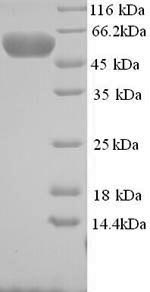The production of recombinant human E3 ubiquitin-protein ligase MYLIP in yeast involves co-cloning the gene of interest (1-445aa of human MYLIP) into an expression vector with an N-terminal 6xHis-tag gene and transforming it into yeast cells. These cells are cultured to induce protein expression. After sufficient growth is achieved, the cells are lysed to release the recombinant MYLIP protein. The harvested recombinant MYLIP protein is purified from the cell lysate through affinity chromatography. The purity of the MYLIP protein is assessed using SDS-PAGE, greater than 90%.
Human MYLIP, also known as IDOL (Inducible Degrader of the LDL Receptor), plays a crucial role in cholesterol regulation by regulating the LDL receptor (LDLR) pathway [1]. MYLIP is abundantly expressed in almost all human tissues, suggesting additional functions and targets for this protein [2]. The N342S MYLIP polymorphism has been associated with high total cholesterol levels and increased LDL receptor degradation in humans [1]. MYLIP is also involved in the degradation of Very Low-Density Lipoprotein Receptor (VLDLR) and Apolipoprotein E Receptor 2 (ApoER2), indicating its broad role in lipid metabolism and nervous system physiology [3].
References:
[1] D. Weissglas‐Volkov, A. Calkin, T. Tusié-Luna, J. Sinsheimer, N. Zelcer, L. Ribaet al., The n342s mylip polymorphism is associated with high total cholesterol and increased ldl receptor degradation in humans, Journal of Clinical Investigation, vol. 121, no. 8, p. 3062-3071, 2011. https://doi.org/10.1172/jci45504
[2] D. Lindholm, B. Bornhäuser, & L. Korhonen, Mylip makes an idol turn into regulation of ldl receptor, Cellular and Molecular Life Sciences, vol. 66, no. 21, p. 3399-3402, 2009. https://doi.org/10.1007/s00018-009-0127-y
[3] K. Hatta, J. Guo, S. Dhingra, K. Singh, M. Huang, R. Weiselet al., Expression of cnpy2 in mouse tissues: quantification and localization, Plos One, vol. 9, no. 11, p. e111370, 2014. https://doi.org/10.1371/journal.pone.0111370






